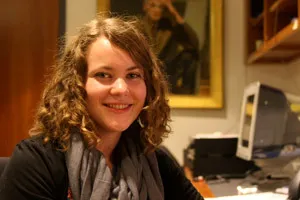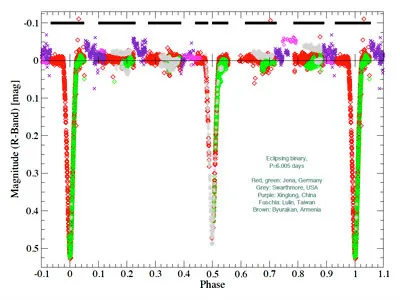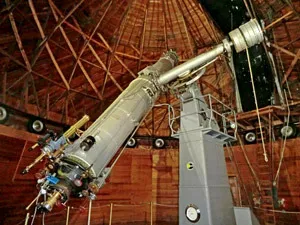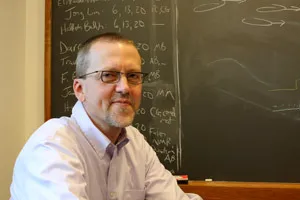Planet Hunters

Sierra Eckerd says her English-major mind balances her astrophysical mind: "My 'English mind' attends to unquantifiable aesthetics, while my mathematical and astrophysical mind, to the logic and reasoning in solving a problem. These sensibilities complement each other, so that I seek not just how but why knowledge of particular astronomical phenomena matters in the grander scheme."
Sierra Eckert '14 caught the astronomy bug in her hometown of Flagstaff, Ariz. That's a little like catching the film bug in Hollywood or the chocolate bug in Hershey, Pa., because in addition to being a gateway to the Grand Canyon, Flagstaff is home to the historic Lowell Observatory and its 24-inch refracting telescope, with which Percival Lowell (1855-1916) studied Mars, discovered asteroids, and predicted the existence of Pluto.
Arriving at Swarthmore, Eckert found that her first-year academic adviser was astronomy professor David Cohen—a pairing that was probably less than coincidental. Although she planned to major in English, she enrolled in Physics 005, an introduction to special relativity, cosmology, and quantum theory co-taught by astronomy professor Eric Jensen and physicist Amy Bug. When Eckert was looking for a campus job, Cohen suggested she join the first training class for student operators of the College's new 24-inch reflecting telescope in the Peter van de Kamp Observatory.
This year, as a sophomore, Eckert spends a couple nights a week—when skies are clear—in the control room atop the Science Center, where Swarthmore students are taking part in a project to locate and study planets orbiting young stars.
Jensen explains: "One of the many open questions in astronomy is how quickly planets form around a new star. We know from radioactive dating that the Earth and Mars took about 30 million years to coalesce from the disk of matter surrounding the Sun. Some models suggest that planets might form more quickly than that, but we're not sure."

A preliminary light curve from an eclipsing binary star in the cluster Trumpler 37. The steep valleys are the transits of one star eclipsing a brighter companion about every six days. The observation proved that it was possible to combine data from five different observatories around the world, allowing nearly continuous observation of the star. (Data from Swarthmore's van de Kamp Observatory is in gray.)
The discovery of extra-solar planets—associated with stars outside our solar system, also known as "exoplanets"—has accelerated in recent years. More than 500 such planets have been confirmed, Jensen says, even though it's almost impossible to see them directly. They're found when the planet moves between us and its star, creating an eclipse or "transit" that temporarily dims the star's light.
Swarthmore's van de Kamp telescope is one of 19 small- to medium-sized instruments at observatories around the world that are part of the Young Exoplanet Transit Initiative (YETI), which looks for such transits in star-forming regions where large clouds of gas have "recently" given birth to stars that are less than three or four million years old. (By comparison, the sun is estimated to be 4.5 billion years old—more than a thousand times the age of stars being studied by YETI.)
Because members of the YETI group are widely spaced around the globe, a target star can be continuously monitored for several days at a time by different instruments. If a regular periodic variation is found, follow-up observations are made to confirm the existence of a planet—or at least rule out other variables.
By timing the transits and measuring the depth of the "light curve" as the star dims, astronomers can get a rough idea of the size and distance of a planet-like object relative to its star. The deeper the curve, the more the star has been occluded, either because the eclipsing object is large or it is very close to the star—or both. This means that a Jupiter-sized planet is a lot easier to find than an Earth-sized one.
"I hunt for planets," wrote Eckert in a recent Daily Gazette article. "Yes, here at Swarthmore."

Sierra Eckert grew up in Flagstaff, Ariz., home of the historic Lowell Observatory. Last summer she worked there running public programs. Percival Lowell is best known for his sketches of Mars showing an elaborate system of canals on the red planet—a speculative idea that was not definitively disproved until spacecraft photographed the planet close-up in the 1960s. The Lowell is also where researcher Clyde Tombaugh tracked down Pluto in 1930. Percival Lowell and others had predicted the existence of the so-called "Planet X" as early as 1906.
In fact, she explains, "Swarthmore's connection to planet discovery is nothing new. In 1914, Swarthmore's Sproul Observatory loaned a 9-inch telescope to search for the then-elusive 'Planet-X,' which would later be renamed 'Pluto' (and still later deemed not a planet)."
There's more: Professor Peter van de Kamp, director of the Sproul Observatory from 1937 to 1972, for whom the College's new observatory is named, spent years at Sproul's 24-inch refractor (almost identical to Lowell's), trying to detect the gravitational tug of planets on their stars. He famously announced in 1963 that he had found a planet orbiting nearby Barnard's Star. Although this claim later proved to be a systematic observational error, van de Kamp's frequent assertion that planetary systems must be quite common has turned out to be true.
There may be a lot of exoplanets, but they aren't necessarily easy to find. "The numbers are against you," Jensen says. "Probably not every star has a planet, and far fewer will have their orbital plane aligned between us and the star. You do the best observations that you can."
Jensen's long-term research interest in planet formation has been focused on young, nearby stars and on the behavior of protoplanetary disks around binary stars—a star system with two stars orbiting around a shared center of mass. (Among the stars nearest the Sun, about half are known to be binaries.)

Professor Eric Jensen notes "We know from radioactive dating that the Earth and Mars took about 30 million years to coalesce from the disk of matter surrounding the Sun. Some models suggest that planets might form more quickly than that, but we're not sure."
The YETI is "a very natural extension of this work," Jensen says. "It's a field that has opened up a lot in the past 10 years—plus it's scientifically interesting and accessible to students. One challenge at a liberal arts college is to effectively plug into big-science collaboration to give students the best view of the forefront of the field. But it's also good for them to do individual research projects that are less well—defined—where they can learn how to pose their own questions and look for the answers."
At Swarthmore, student research experience often comes from collaborating with professors on their investigations—then branching out to do something on one's own. In addition to her campus job running the telescope for the YETI, Eckert is currently assisting Professor Cohen with his work on massive, hot stars that are ejecting superheated plasma, so that they are losing mass. "We're collecting data on a pair of binary stars with very hot x-ray emissions," Eckert says excitedly.
Eckert says she's "privileged and lucky" to be able to combine such disparate interests as English literature and astrophysics at Swarthmore. In her English classes this year, she's been reading works from John Donne to Mary Oliver, from Paradise Lost to Howl. She often reads at night in the quiet observatory control room. Looking over her shoulder, in an oil portrait on the wall by the door, is Peter van de Kamp. The scene would no doubt make him—and perhaps even Percival Lowell—very happy.



